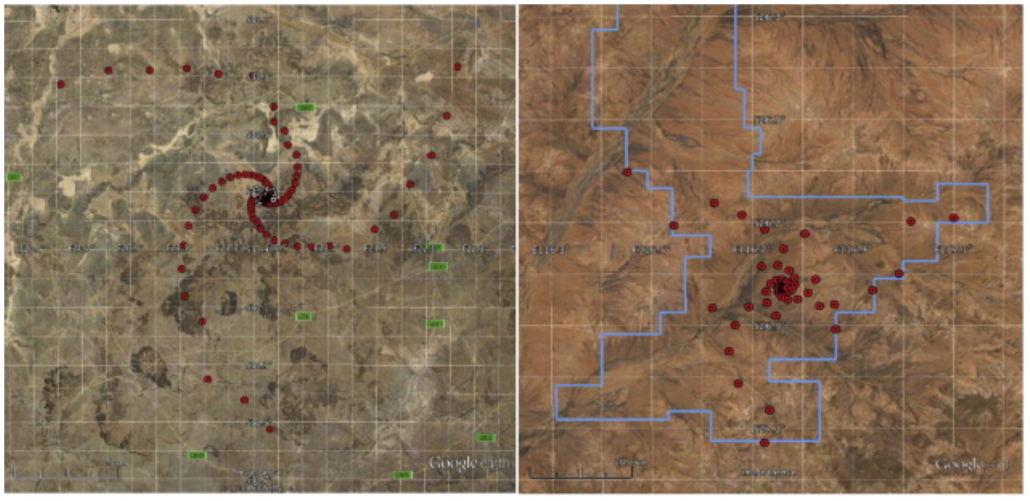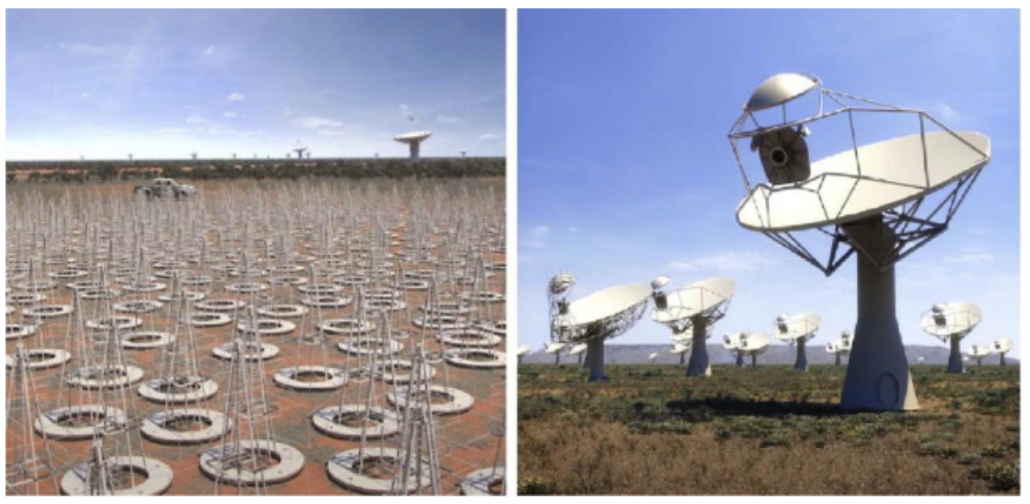Although solar physics is one of the most mature branches of astrophysics, the Sun confronts us with a large number of outstanding problems that are fundamental in nature. These problems include the determination of the structure and dynamics of the solar atmosphere, the magnetic field evolution in the chromosphere and corona, coronal heating, the physics of impulsive energy release, energetic particle acceleration and transport, the physics of coronal mass ejections (CMEs) and shocks, as well as the solar origin of space weather drivers.
The Square Kilometre Array (SKA) will be the largest radio telescope ever built, aiming to provide collecting area larger than 1 km2. The instrument will be built in two phases, known as SKA1 and SKA2. SKA1 will correspond to about 10% of the final collecting area and its deployment will start in 2020 while commissioning activities are expected to start in 2024. SKA2 will correspond to the full final system and its construction will start, subject to the performance of SKA1, after 2030.
The SKA1 will consist of two arrays, SKA1-LOW and SKA1-MID, that will be built in Australia and South Africa, respectively. The expected configuration of the two arrays is presented in Fig. 1. The maximum baselines of the arrays will be about 65 km for SKA1-LOW and about 150 km for SKA1-MID.

Figure 1 – Geophysical maps with the SKA1-MID (left) and SKA1-LOW (right) configurations. The horizontal lines at the bottom left corners of the maps correspond to 40/20 km (left/right map). Image credit: SKAO.
The SKA1-LOW will observe from ~50 to 350 MHz and will include about 131,000 simple antennas that are arranged in 100-m diameter stations each hosting 90 dual polarization antennas. In each station the signal of all antennas will be added in phase, allowing the formation of an ‘‘aperture array” (see Fig. 2, left). The separation between stations will increase from the central part of the array toward its outer edge, reaching several kilometers there. The SKA1-MID will observe in the range from 350 MHz to 15.3 GHz which will be divided into three frequency bands. The array will include 133 15-m-diameter dishes (see Fig. 2, right) and will also incorporate the 64 13.5-m-diameter dishes of the MeerKAT array.

Figure 2 – Artist’s impression of the SKA1-LOW aperture arrays (left) and SKA1-MID dishes (right). Image credit: SKAO.
In Table 1 we present a summary of SKA1’s specifications. They represent an unprecedented improvement over all existing radio telescopes and will allow SKA1 to contribute to decisive advances in practically all branches of modern astrophysics.
|
Parameter |
SKA1-LOW |
SKA1-MID |
|
Frequency range (MHz) |
50 – 350 |
350 – 15300 |
|
Angular resolution (arcsec) |
4 – 24 |
0.025 – 1 |
|
Time resolution (s) |
0.001 – 9 |
0.001 – 9 |
|
Frequency resolution (kHz) |
5 |
15 – 76 |
|
Field of view (deg2) |
2 – 39 |
≤ 1.4 |
|
Largest angular structure (arcmin) |
60 – 500 |
15 – 80 |
|
Sensitivity (x 10-3 sfu) |
0.46 – 4.00 |
0.16 – 0.90 |
Table 1 – Summary of SKA1 specifications.
The SKA will conduct two kinds of observations, interferometric imaging and beamforming. All interferometric imaging observations will be spectroscopic. For a given subarray operating in ‘‘interferometric mode”, each pair of stations will be cross-correlated to provide full-polarization visibilities across the requested bandwidth and number of channels. In the ‘‘beamforming mode” each subarray can form several tied-array beams and process data for each beam independently.
Solar observations with the SKA
Scientists interested in using the SKA for their research have formed ‘‘Science Working Groups” (SWGs). One of them is the ‘‘Solar, Heliospheric and Ionospheric” (SHI) SWG. It has more than 60 members from four continents and 20 countries and it is currently chaired by E.P. Kontar (Glasgow) and D. Oberoi (Pune). The scientific interests of the SHI SWG include the quiet Sun, non-flaring active regions, solar flares, CMEs, the solar wind, the Sun-Earth system, and the ionosphere. The SHI group has established that both SKA1-LOW and SKA1-MID will be able to observe the Sun both in interferometric imaging and beamforming modes.
Solar physics will benefit immensely from the deployment of the SKA1 because its unprecedented angular, spectral, and temporal resolution, as well as sensitivity will provide major new insights into many important solar physics problems. Details about open issues on solar radio astonomy and how the relevant SKA observations can bring results of transformative nature are discussed in Nindos et al. (2019). A brief summary is as follows.
Observations of the non-flaring corona will allow to probe its structure and evolution with unprecedented details. The detection of numerous weak transient events could facilitate the derivation of reliable estimates about their contribution to coronal heating in the framework of the nanoflare model.
A very important outcome of SKA1 observations will be the direct and indirect measurements of the magnetic field at heights inaccessible by other instruments. The measurements can be used both for the computations of free magnetic energy budgets as well as for the diagnosis of the magnetic field of active regions, flaring loops, and CMEs.
SKA1 observations will provide a comprehensive view of coherent and incoherent emissions that are intimately related to electron acceleration, of gyrosynchrotron emission from precipitating and trapped electrons in flaring loops, as well as of CMEs, shocks, and related phenomena. These observations have the potential to provide major advances towards addressing key solar physics questions about: (1) the location and magnetic configuration of the electron acceleration site; (2) the mechanism(s) responsible for particle acceleration; (3) the flare-CME relationship; (4) the timing and evolution of CMEs from the early stages of development all the way to the outer corona; (5) the drivers of coronal shocks as well as the locations and efficiency of electron acceleration by shocks; and (6) the origin of SEPs.
Finally, SKA1 observations will also have a strong heliospheric component because they could provide constraints on turbulence and waves in the solar wind (see Nakariakov et al. 2015, for details).
Above all, as is always the case with new instruments that outperform their predecessors in significant ways, is the high probability of new discoveries that cannot yet be predicted . This exciting prospect is further boosted by the availability of synergistic activities between the SKA and the new generation of ground-based and space-borne solar instruments.
For more details, see Nindos et al, ”Solar physics with the Square Kilometre Array”, Adv. Space Res. (2019), doi: 10.1016/j.asr.2018.10.023
References
Nindos, A., Kontar, E.P., Oberoi, D.: 2019, Adv. Space Res., 63. 1404.
Nakariakov, V., Bisi, M.M., Browning, P.K., et al. 2015, in Bourke, T., Braun, R., Fender, R. (Eds.), Advancing Astrophysics with the Square Kilometre Array (AASKA14), p. 1875.
*Full list of authors: A. Nindos, E.P. Kontar, D. Oberoi
